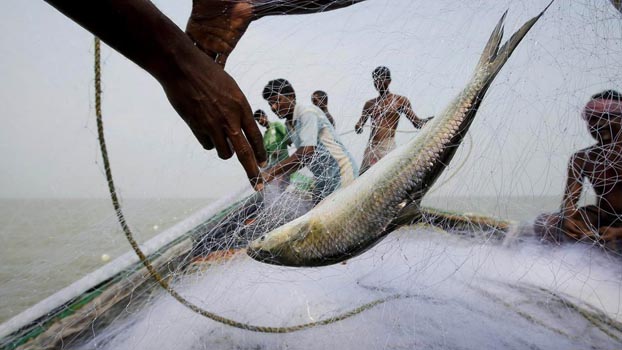Hilsa migration worrying fishers

Hilsa fish is migrating from rivers to deep sea areas due to pollution and other reasons worrying the fishers of the major rivers of the country.
According to fishers, huge amount of Hilsa is being caught in the deep sea. On the other hand, fishermen are not getting enough Hilsa in rivers.
Many fishers of the country have expressed deep concern over this matter.
The availability of Hilsa, the national fish, is expected this year like the last few years. However, a significant difference was seen in its wandering areas.
Experts said that increasing siltation at river-mouths has blocked the fish’s migration routes. The overall environment of Hilsa’s roaming areas including Bammaputra-Ganga-Meghna basinin inland rivers is not appropriate. Moreover, the increased movement of trawlers and other water vesselsis another reason for the Hilsa shortage. Dams and barrages also obstruct the upriver migration of the fish.
This situation is alarming as the less amount of Hilsa will decrease the chance of more Hilsa production, they added.
In Chattogram areas, the southern of Sandwip in the Meghna estuary of Bay of Bengal is one of the four major migratory areas for Hilsa. Even in the middle of the season, small boat owners do not have much Hilsa in their nets in the areas.
Ratan Das,a fisherman of Chattogram, said, “Every year fishermen from other areas come here to catch fish. However, we have seen a very little presenceof the fishermen this year as they have moved to other areas due to a lack of Hilsa fishes.
Earlier, we were dependent on only Hilsa fishing but this season we are netting other fishes as well, he added.
However, some six lakh tonnes of Hilsa fishes have been caught so far.
Rajibul, another fisherman of Patenga area of Chattogram, said that the number of Hilsa fish has decreased in their area due to overfishing for several years.Overfishing had decimated Hilsa stocks in this part.
“It is a quite normal and natural phenomenon.So we are trying to catch other fishes,” he added.
Fishers with small boats and poor fishing gears hardly get Hilsa. On the other hand, fishermen with large boats and trawlers net a plenty of Hilsa fishes from the deep sea.
Aminul Islam Babul, General Secretary of the Mechanical-Non-Mechanical Boat Fishermen's Cooperative Society, said there was no shortage of Hilsa fish in the deep sea areas of the Bay of Bangal. Huge numbers of Hilsa are being netted now in the East, South Chattogram -Cox's Bazar areas and in the west of the Meghna estuary from Bhola to the Sandurbans areas.
He said, “Hilsa is less available in upper Meghna River and the basin areas of the Meghna. The areas also known as a sanctuary.”
“No place is fixed for Hilsa as they move to their convenient places. So the fishes can be found in different areas of the country,” he added.
As Abdul Latif, the director of the Department of Marine Fisheries, told Bangladesh Post, “The movement of Hilsa is being hampered due to the installation of extra nets at the entries of the rivers. Moreover, the increase in salinity and pollution in the river water are to be blamed for the migration of Hilsa fish,” he added.
In the last few years, Hilsa has been found equally in the sea and rivers. It was found even in the Northern most rivers Teesta and Dharla of the country where the national fish hardly could be found earlier.
DrAnis Ur Rahman, Chief Scientist of Fisheries Research Institute of Chandpur, told, “The number of Hilsa has been decreased due to the pollution in the rivers and overfishing in estuary area.”
Dr Sayedur Rahman Chowdhury, Professor Marine Science Institute of Chattogram University, said, “The low presence of Hilsa means they are not breeding in a large number in the rivers. This will directly put an impact in the Hilsa production in near future.”
Hilsa is basically a saline water fish of the deep sea. It moves to fresh water for laying eggs.
Bangladesh has the largest catch of Hilsa fish in the world, which is about 80 percent. Its contribution to the GDP is about 1 percent. Hilsa is 12 percent of the total fish production in the country.





